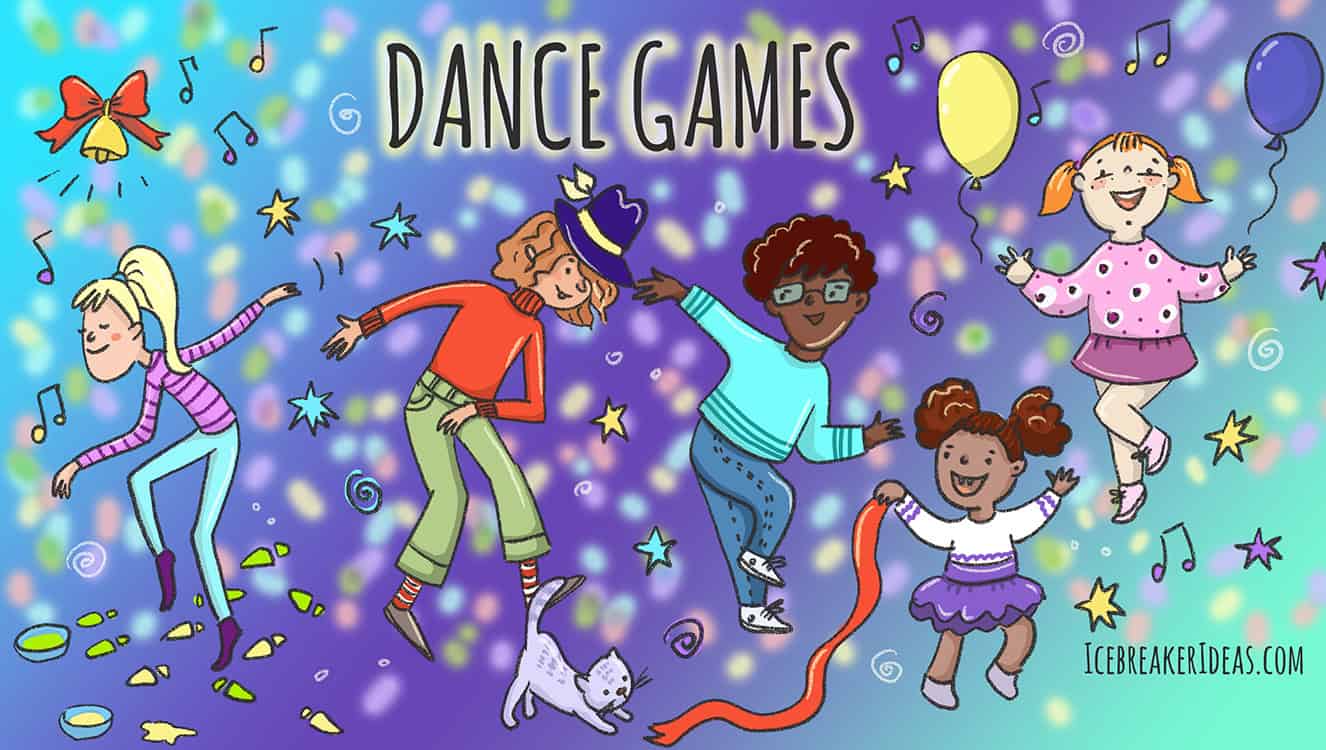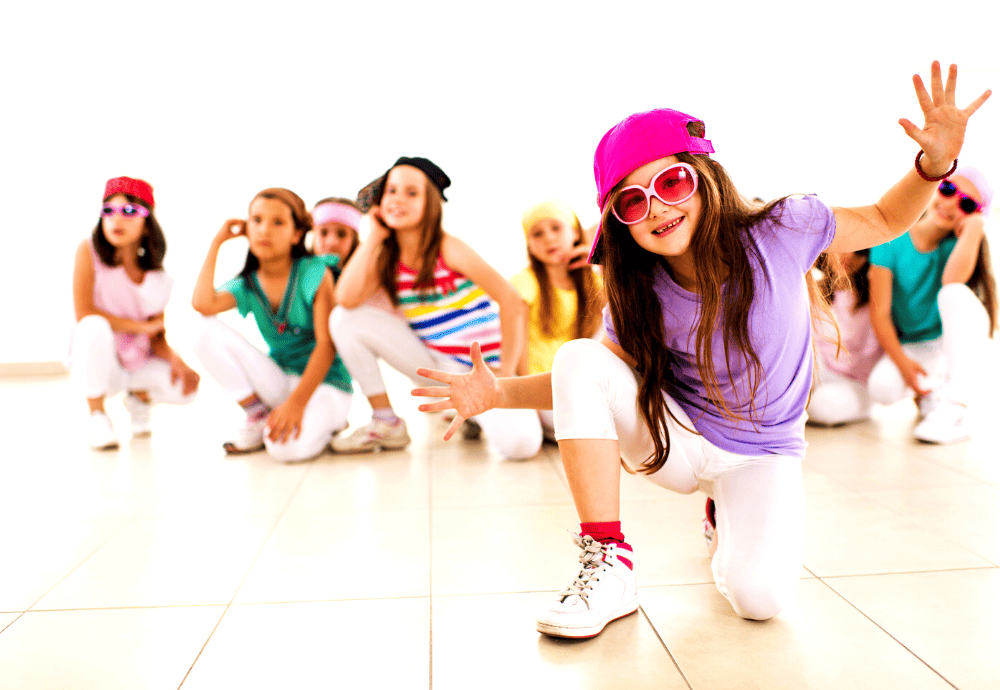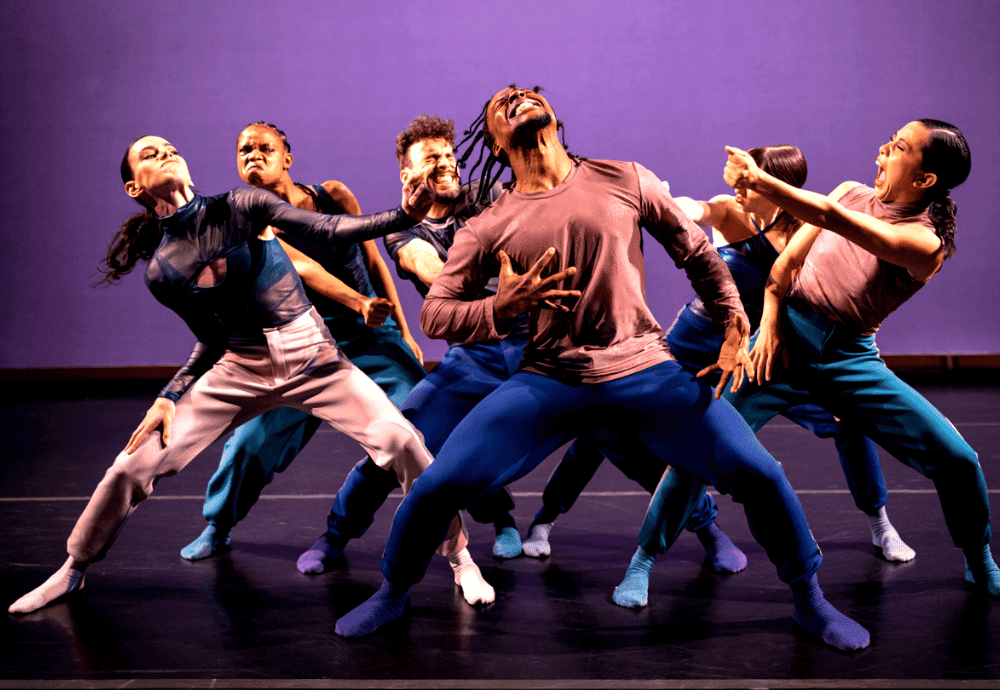Dance games are fun for everyone who participates. Even the shyest, most hesitant individual will get caught up in the excitement and move to the music. In this article, we will share dance games for both kids and teenagers. We have detailed two special dance types with sections on “Hip-hop Dancing Games” and on “Ballet Games.” The article ends “Fun Dance Activities” which do not include actual dancing.
Table of Contents
Whether you lead a group participating in the dance games, or are a participant yourself, you are guaranteed to have fun!
Dance Games for Kids
When kids have high energy or complain, “I’m bored!” introducing a dance game directs their energy and provides entertainment. From toddlers to the beginning of the teenage years, our dance games for kids will provide fun in the classroom, at camps, and at parties. We will tell you what supplies you need for each game, although some only require music and eager participants.
Ball Dancing
All you need for this simple game is a bell, a ball, music, and a place to dance. It is a great way to introduce your kids to the fun of dancing games. Have the children line up in a row or form a circle. Start the music and give the ball to a child, directing them to dance and pass the ball to another kid when you ring the bell. The one who passes the ball steps out of the line or circle. This continues until everyone has had the ball passed to them.
Freeze
All you need for this fun game is music. Instruct the kids to dance to the music and stop when the music stops. The kids are to freeze in place and the last one moving is out. Continue until you have only one dancer left – the winner.
Balloon Dancing
“Balloon Dancing” is a great party game for kids. You will need some blown-up balloons, two for each dancer.
Play some music and instruct the kids to dance to the music while juggling their balloons. Stop the music when you see dancers dropping their balloons to give those who do so time to leave the dance area. The dancer who remains on the dance floor the longest juggling their balloons wins this fun game.
Alternative Play:
Put the kids in pairs or teams and have them pass a balloon back and forth while the music plays. The pair or team that does so the longest and keeps their balloons off the floor wins.
Beat Jumping
An important part of dancing is being able to move to the beat of the music. Teach kids to do so without effort with this peppy game. “Beat Jumping” also increases physical ability, as the game is quite strenuous.
Put on some music with a fairly fast beat and direct your kids to jump to the rhythm of the music. If you wish, you can surprise them by switching to a piece of music with a slower beat occasionally.
Ribbon Dancing
This active game increases imagination, requires flexibility, and improves eye-hand coordination. You will need sticks with ribbons attached, one for each dancer.
Provide a stick to each dancer, instructing them to dance to the music waving their sticks and ribbons as they do so. Try different of music; classical works well, as does jazz. Older kids might enjoy being in pairs or teams and choreographing a dance to share with the other kids.
Elimination
Observe your group and write down descriptive phrases on index cards, such as:
- Wearing a blue shirt
- Wears glasses
- Has a pony tail
- Has on black pants
Put the index cards in a basket or paper bag. Turn on the music and have your kids dance while you pull out a random card and read it. If the description on the card matches a dancer, they are out. The last dancer remaining is the winner.
Paint Dancing
Combining the two artistic expression of painting and dancing can create a memorable experience. For this dance activity, you will need some washable paints, some bowls or plastic containers large enough for the dancers to place a foot in, and a washable, plain, floor mat.
Have the kids take turns standing on the mat. Instruct them to dip their foot into a bowl and move around in time to music you play. As the kids do so, they will create a colorful, unique painting.
Variation:
If your group is large, divide the kids into pairs or teams and use plain white butcher paper taped to the floor to create more than one painting.
Dance Games for Teens
Teenagers are sometimes hesitant to try new activities. However, we have collected a group of dance games for teens sure to please them while working off some energy.
Dance games are an excellent way to get your teens to socialize. We suggest you use these dance games in the classroom, at camp – anywhere teens gather to have fun.
Switch It Up
You may be surprised at how many dance moves and styles your teen dancers know. Play any of the following music types or others of your own choosing:
- Waltz
- Hip-hop
- Jazz
- Country line dance or square dance
- Disco
- Ballet
- Samba, rumba, or mambo
Instruct your teens to change their dance styles as you change the music. You may find that they spontaneously choose a partner or form groups for some of the types of music you play.
Choreography
Creating a unique dance exercises one’s imagination. Have your teens form a line. Choose a student to begin the choreographed presentation. Turn on the music and have the chosen teen show a dance move. Have the teens take turns doing so. Each time a new dance move is introduced, the group does the previous dance move(s) and the new one. Stop when you feel the teens can no longer remember more moves or everyone has taken a turn.
Emoji Dancing
Teens love an emoji, and this game uses that interest to engage them in a fun activity. Start by creating (or purchasing) flash cards with an emoji on each one. Choose music that matches the mood to play for each one. Songs and instrumental music both work well. Line up the teens and instruct them to dance to match the emotion or mood of the emoji shown.
Passing Hats
Scout thrift stores and garage sales for interesting and unique hats for this fast-moving dance game for teens. Similar to playing a game of hot potato, a hat becomes the item everyone wants to avoid. Place a hat on a teen’s head and start the music. The hat is passed as the group dances. Dancing makes passing and receiving the hat more difficult. When the music stops, the teen with the hat is out of the game. The teen left at the end is the winner.
In the Spotlight
If you do not have an actual spotlight, a flashlight can be used for this fun game. Turn the lights to a lower setting so that everyone can easily see the spotlight.
Play whatever type of music you wish and direct your teens to start dancing. Choose one teen to hold the flashlight, shining it for ten to twenty seconds on each dancer. When you stop the music, the dancers all freeze, and the dancer in the spotlight is out of the game. The winner is the dancer left on the floor at the end of the game. If your teens wish, you can let them dance as couples.
Hip Hop Dancing Games
Many young people want relevant music – music that relates to their life experiences. Urban youth are probably familiar with hip-hop, but in rural areas, you may find children unfamiliar with this dance form. Exposing children to new and different performing arts deepens their cultural awareness and helps them appreciate diversity.
Hip-hop Dancing
Since not everyone is familiar with hip-hop, you may want to find some videos on-line to demonstrate hip-hop dancing. Then let your dancers choose from a pre-made list of songs whose lyrics you have reviewed ahead of time to make sure there is nothing inappropriate. Tell them to freestyle, paying attention to the rhythm and the mood(s) of the song. Encourage them to be creative in the steps they choose to do.
Hip-hop Dance Moves
There are many hip-hop dance moves. Some are relatively simple, and others take quite a bit of practice to perfect. Again, use videos to explain and demonstrate hip-hop dance moves. The following list includes some fairly simple ones whose names denote the movement and, therefore, are easy to remember.
- Running Man
- Stomp
- Basketball
- The Snake
- Walk it out
- Penguin
- Upstairs Downstairs
- Happy Feet
- Crazy Legs
- Lite Feet
- Old Man
- Rocksteady
- Walking Backwards
- Run It
Call and Response
“Call and Response” is commonly part of hip hop dances. Have your dancers stand in a circle. Choose a student to start this exercise, performing a gesture or move. The next person in the circle responds. This pattern continues, with each person in the circle performing a different gesture or move until all dancers have taken a turn.
Handshakes
Divide your dancers into pairs and instruct them to create a handshake routine including five or more handshakes. This exercise helps your dancers to recognize how powerful nonverbal conversation can be. When your dancers have created their handshake routine, have each pair demonstrate it for the other dancers.
Act Out an Emotion
Create some cards (notecards work well) with an emotion on each. Dancers take turns choosing a card and creating a hip-hop dance or move demonstrating the emotion on the card. For example, a dancer may express fear by backing away with hands out in front as if to ward off an enemy. Have the group guess what emotion the dancer is attempting to convey.
Ballet Games
Although you may consider ballet a more serious dance type than some others, ballet dancers still appreciate some fun games. Our ballet games are perfect for class warm-ups or breaks to let your dancers relax and get ready more demanding ballet exercises.
Snowball “Fight”
Write a dance movement on a piece of plain white paper. Scrunch each paper piece into a round ball. How many you need will depend on the size of your group.
Play some fun music and have the dancers throw the snowballs at each other. Direct the dancers to pick up the snowball closest to them when the music stops. Each dancer does what is indicated on the paper.
Start the music and repeat this exercise until you feel each dancer has had a chance to try several dance movements.
Book Balancing Ballet
You will need some books that are not too heavy, one for each dancer.
The goal is to maintain good posture and control one’s body while moving to music and practicing some ballet movements.
Play some music and have your dancers try to keep their book on their head. If a dancer’s book falls, they are fine if they can catch it. However, if the book hits the floor, they are out.
Meeting in the Middle
“Meeting in the Middle” can be for any age, as you can make the dance steps you request easy or more challenging.
Have half of your dancers stand on one side of the room and the other half on the other side of the room. A dancer from each line meets in the middle by performing a travelling step. You can assign a step or let the dancers choose their own. The dancers must touch hands and then return to the line. Repeat until every dancer in the line has met in the middle.
Stretch with a Story
Have your dancers sit in a straddle position, imagining they are a tall castle. They are to pretend the king and queen are walking across the drawbridge to enter the castle, moving their fingers down their legs until they touch their feet, and then bring their fingers back up their legs.
Next, have them pretend they must keep the drawbridge straight or the king and queen will fall off. Have them stretch forward with their backs flat, keeping their legs together.
Statues
Have your dancers partner up. The goal is to sculpt your partner’s body into a dancer’s pose. Once the pose is perfected, have the sculpted dancer hold the pose while the other member of each pair observes the statues.
Next, have the partners change places to sculpt again. If you wish, you can assign poses or give directions, such as:
- Make a curved shape.
- Do a low-level sculpture.
- Lean to one side.
- Stretch and hold a position.
Fun Dance Activities
When you hear the word “dancing,” you may think of the physical act of doing so. But dance is so much more. Perhaps your class cannot actively dance one day for a good reason. Or maybe you like to have productive relaxing times between dance movements. The following list of non-dancing activities will provide physical, emotional, and intellectual stimulation for your dancers.
Watch Dance Performances
Watching dance performances of the great dancers of the past provides inspiration. You might wish to watch clips of Broadway musicals online. Don’t ignore local dance recitals. Remember that every dance you see can add to your own dance abilities.
Explore the History of Dance
Whenever one has an interest, it helps to know everything you can about its history and origins. Your local library, museum, and the internet all provide information on famous dancers, costuming, and dance moves. The more you know, the more you will be able to appreciate and enjoy dance activities.
Increase Your Physical Abilities
Dancing can require strength and stamina. Any form of physical exercise can enhance your dance ability. Even the youngest dancers can practice breathing skills by blowing up balloons. Walking in a straight line or doing stretches helps a dancer with balance and movement control.
Clap or Stomp Away
Even non-dancers love music and clapping or stomping to a song provides interaction with music, helps with balance and coordination, and teaches rhythm. Play a variety of music to make the most of this fun activity.
Some Final Thoughts
Whether you teach dancing, enjoy it as a dedicated dancer, or simply choose to sit and watch others dance, our fun dance games and activities can meet your desire to enjoy dance experiences.
Dance games have many benefits, including the following:
- Build self-confidence
- Easy for anyone to participate
- Enhance flexibility
- Increase self-expression
- Increase socialization
- Reduce tension and stress
Whatever your interest or experience level, we hope you learn from and enjoy this collection of dance games and activities. Dance away and have fun!
Susan majored in English with a double minor in Humanities and Business at Arizona State University and earned a Master’s degree in Educational Administration from Liberty University. She taught grades four through twelve in both public and private schools. Subjects included English, U.S. and world history and geography, math, earth and physical science, Bible, information technologies, and creative writing.
Susan has been freelance writing for over ten years, during which time she has written and edited books, newspaper articles, biographies, book reviews, guidelines, neighborhood descriptions for realtors, Power Point presentations, resumes, and numerous other projects.



